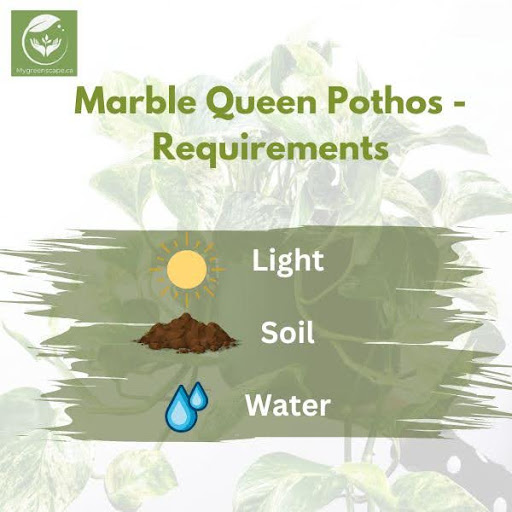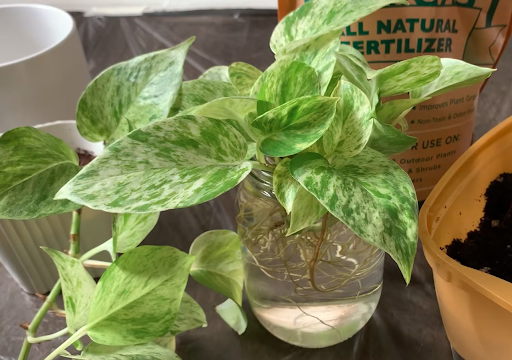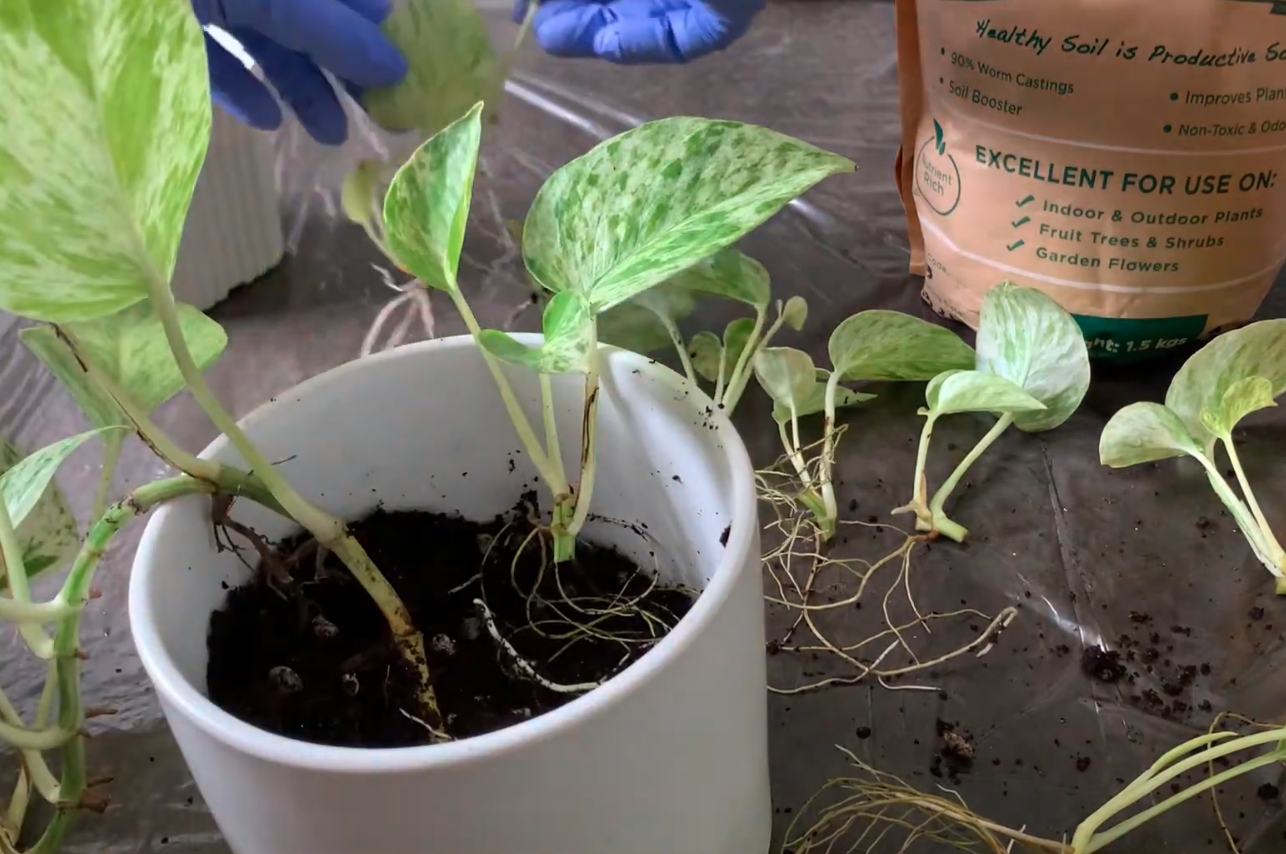Marble Queen Pothos is an amazing option to start indoor gardening. Not just because of its beauty but due to its easy maintenance. Whether you are a busy bee or a newbie to gardening you can grow it effortlessly.
Yeah, you read it right this charming plant doesn't demand much care. It’s highly adaptable.
But wait, there's more! it's a mood lifter too. Like a beautiful cheerful friend ready to welcome you after a long day.
Interested in growing this plant? Trust me there are just a few simple considerations!
This article will guide you from its basic care to various propagation techniques. We will also discuss some common plant problems. After reading this article you will be all ready to grow Marble Queen Pothos!
So without further ado Let’s Get Into It!
What is Marble Queen Pothos Plants
The Marble Queen Pothos Plant, a common Pothos variety, has its origin in French Polynesia. Scientifically it is known as Epipremnum aureum plant and belongs to the Araceae family. It is now widely grown as a house plant. Its specialty lies in its unique appearance.
It has striking heart-shaped leaves that have creamy-white and green hues.
This beautiful plant shares many of its characteristics with its Araceae family. Such as it climbs and has aerial roots. It has the unique ability to clean the indoor atmosphere.
So, when we mentioned above that this plant is a mood lifter we were not kidding!

How to care for Marble Queen Pothos
As we've already discussed Queen Pothos are super easy to grow. So, there is no need to keep a laundry list of do's and don'ts in the name of their maintenance.
Just give a little attention to their requirement for light, water, and soil and they are good to go.

Light Requirements
This plant can grow well in indirect light that can be medium to bright. You just need to place it near some window from where it can get filtered sun rays. However, just avoid placing them in direct sunlight or extremely low light for a long period of time. This can scorch Its leaves.
Soil Requirements
When it comes to the soil you need to use a mixture of peat moss, perlite, and pine bark. It works well. The best part is you can create this soil yourself!.
Just mix the equal parts of potting soil, perlite, and orchid bark.
However, always use a well-draining pot to grow it. Drainage holes in the pot can prevent waterlogging in these plants. Waterlogging can badly affect its roots.
Water Requirements
Proper watering is essential for this plant. You just need to wait until the top surface of the plant’s soil dries out. After this period, water the plant until water starts to drain from the pot’s holes.
Overwatering can be damaging to these plants. It can cause yellowing of the leaves or even wilting. To ensure the right moisture level for this plant you can use a moisture meter or simply use your finger.
Temperature and Humidity Needs of Marble Queen Pothos
This plant adapts quite easily to indoor conditions which makes it an ideal indoor companion.
Let’s find out what temperature and humidity conditions suit them well:
Ideal Temperature
These plants grow well at average room temperatures that can range from 65 to 85°F (18°C to 29°C). At this temperature, they show vigorous growth and overall good health.
Effects of Temperature Extremes
Cold temperatures such as 55°F(13°C) or less, or warm temperatures 95°F (35°C) or more aren’t good for the growth of these plants.
They may grow slowly or start to show leaf drop. This is because exposure to temperatures outside the ideal range temperatures can stress these plants.
Prolonged exposure to extreme temperatures makes it difficult to absorb enough moisture required for their growth.
Humidity
However, it is not essentially required for their growth and development but if a very humid environment is maintained around these plants they grow substantially.
A humid environment can be maintained by:
- Placing them near humid places like kitchens or bathrooms.
- You can also place them near the humidifier.
- Place them on the top of a tray filled with pebbles and water.
These ways can help maintain a humid environment thus helping them show good growth.
Nutrition and Fertilization
Apart from the above mentioned factors, there is another factor that can help Queen Pothos grow well. It is the seasonal fertilization of these plants.
Signs of Nutrient Deficiency
The signs of nutrient deficiency include:
- Yellowing of Leaves
- Stunted Growth
- Pale Foliage
To address these issues, you can use fertilizers. If already using one then adjust your fertilization schedule or consider switching to some other fertilizer options.
Fertilization
To provide the required nutrients to these plants you need to maintain scheduled fertilization. It would be given every 4-6 weeks during growing seasons (spring and summer). It can do magic.
Go for the fertilizers with equal parts of nitrogen phosphorous and potassium. It should be water soluble and diluted to almost half-strength.
If even after doing scheduled fertilization your plant isn't showing the desired results. Look for the other two factors (water and sunlight). They might be the culprits. Adjust them optimally.
Propagation Techniques for Marble Queen Pothos
Marble Pothos can easily be propagated through the stem-cutting method.
As this name shows stem cutting involves cutting a part of the stem to grow it into a full-fledged plant.
Follow the steps below to grow your Marble Queen Pothos through stem cutting:
Step 1:
First, you need to cut a part of the plant's stem. Cut it in a way that the stem has few nodes present on it.
Step 2:
Remove the lower leaves to expose nodes. Leave a few leaves on the top.

Step 3:
Place it in a glass bottle or jar filled with water. Place it in a way that the lower part with exposed nodes is submerged in water. Keep the top leaves out of the water.
Step 4:
Next, place it on the spot with medium to bright indirect light. You need to change its water every week.
Step 5:
After 2 to 3 weeks the roots will start to appear from the bottom. Once the roots become almost an inch long, remove them from the water and plant them in the pre-moistured soil.

Step 6:
Keep the soil moist for the first few weeks. Keep the plant again in medium to bright indirect light.

If you don't want to skip the lengthy waiting period of propagation, you can directly order Pothos Marble Queen online. Explore other varieties of Pothos Plants on Mygreenscape as well.
Potting and Repotting Guidelines for Marble Queen Pothos
Another thing you should know about the Marble Queen Pothos plant is after a year or two, it needs to be repotted. The reason is that its roots actually outgrow the pot after this time. Which causes it to circle around the bottom.
Repotting the Marble Queen Pothos
In order to repot your plant:
- Remove it from the previous plant.
- Try to take out as much soil as possible with the plant.
- Place it in the new pot. It should be a few inches larger than the old pot.
- Fill the pot with the suitable soil.
- Place it in its old spot.
Common Pests and Diseases Challenges for Marble Queen Pothos
When growing Marble Queen Pothos plant it's really important to keep an eye on the pest's attack as well.
Common pests that affect this plant include:
- Mealybugs
- Spider Mites
- Scale Insects
- Fungus Gnats
As a protective measure check your plant daily to see if it is doing well and if there isn't any sign of pest infestation. It can help you take action as soon as possible.
Root Rot
Other than these common pest infections your plant can also suffer from root rot. It can result from over-watering or drainage issues.
Common signs of root rot include:
- Wilting
- Yellowing
- Browning
- Mushy stems or roots
- Foul odor
- Reduced growth
If any of these signs appear take the necessary action. Whether it's changing the watering routine or giving your plant a new pot with effective drainage.
FAQs
Are marble queen pothos rare?
Marble Queen Pothos are not considered rare; they're a popular and commonly available variety of Pothos.
How much light does a marble queen pothos need?
Marble Queen Pothos thrive in indirect, bright light but can tolerate low light conditions. Avoid direct sunlight to prevent leaf burn.
Is marble queen pothos hard to care for?
Marble Queen Pothos are generally easy to care for, requiring minimal maintenance. They're adaptable to various light and water conditions.
How to get Marble Queen more white?
To encourage more variegation in Marble Queen Pothos leaves, provide indirect sunlight and avoid over-fertilizing. Prune leggy stems to promote new growth.
Why is my marble queen turning green?
Marble Queen Pothos may turn green due to insufficient light or genetic factors. Ensure adequate indirect light to maintain variegation, or it may revert to solid green leaves.
Conclusion
Marble Queen Pothos is an amazing option for plant enthusiasts, offering beauty and simplicity simultaneously. Its striking appearance requires low maintenance—simply provide direct light and avoid overwatering.
Take care of common pests and repot the plant when necessary. Quite simple, right? Just attend to these few things, and your plant will be ready to please you.










